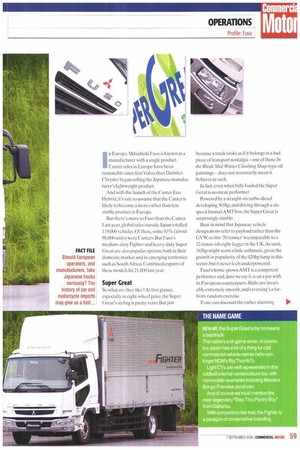I n Europe, Mitsubishi Fuso is known as a manufacturer with
Page 59

Page 60

If you've noticed an error in this article please click here to report it so we can fix it.
a single product. Canter sales in Europe have been reasonable since first Volvo, then DaimlerChrysler began selling the Japanese manufacturer's lightweight product.
And with the launch of the Canter Eco Hybrid, its safe to assume that the Canter is likely to become a more rather than less visible product in Europe.
But there's more to Fuso than the Canter. Last year, global sales outside Japan totalled H9,000 vehicles. Of these, some 83% (about 98,0(X) units) were Canters. But Fuso's medium-duty Fighter and heavy-duty Super Great are also popular options, both in their domestic market and in emerging territories such as South Africa. Combined exports of these models hit 21,000 last year.
Super Great So what are they like? At first glance, especially in eight-wheel guise, the Super Great's styling is pretty retro. But just because a truck looks as if it belongs in a had piece of transport nostalgia — one of those In the Bleak Mid-Vilimer Climbing Shap-type oil paintings does not necessarily mean it behaves as such.
In fact, even when fully loaded the Super Great is no mean performer.
Powered by a straight-six turbo-diesel developing 365hp, and driving through a sixspeed Inomat AMT box, the Super Great is surprisingly nimble.
Bear in mind that Japanese vehicle designations refer to payload rather than the GVW, so this 20-tonnef is comparable to a 32-tonne-ish eight-legger in the UK.As such, 365hp might seem a little asthmatic, given the growth in popularity of the 420hp lump in this sector, but it never feels underpowered.
Fuso's home-grown AMT is a competent performer and, dare we say it, is on a par with its European counterparts. Shifts are invariably extremely smooth, and reversing's a farfrom-random exercise.
If one can discount the rather alarming upholstery pattern chosen by Fuso, the seating is very comfortable, and the driving position isn't bad.The Super Great is clearly designed for the more diminutive Japanese frame but visibility is excellent, particularly from the mirrors.
The rest of the cab is a slightly different matter. Rather than criticisms these comments should be taken as observations borne out of a familiarity with European as opposed to Japanese designs.
Fora start, cross-cab access is non-existent. The engine tunnel sits more or less at waist height, and it's covered by various plastic storage boxes.Think along the lines of an FL Volvo with a cool box on the engine lump and you'll get the idea.
Fighter With a rated payload of j ust under eight tonnes, the Fighter is roughly the equivalent of a European 12-tonner. It's powered by a 265hp engine developing 785Nm of torque, and the standard transmission is also an lnomat AMT unit.
Al] told, it's a good combination. Given that its power-to-weight ratio is greater than 20hp per tonne, no wonder the Fighter doesn't feel particularly stressed under normal conditions. It fairly dances up steep hills with no more than a single downshift.
Once again,the most prominent feature is the performance of the Inomat.As with the Super Great, the installation is on a par with the best in Europe-and far in advance of any similar AMT-configured vehicle CM has driven in the United States Upshifts are seamless and downshifts drop in with minimum jolt.
As with its heavier stablemate visibility is excellent. Hardly surprising, given that Fuso's designers are producing a vehicle that will have to cope with Tokyo traffic which must be one of the most challenging environments on earth. Also like the Super Great, particular mention needs to be made of the mirrors. which are as near perfect as makes no difference.The cab's a touch on the small side compared with its European counterparts, but that's hardly a fair comparison.
The future The future for the Super Great and Fighter looks set to involve more input from Europe and the US. For example, MB's cab design is considerably more user friendly, particularly for full sized European drivers.
And that is the challenge facing DaimlerChrysler. Mercedes. Freightliner and Fuso all offer products based around regional demand. Bringing all three closer will be something of a challenge, but from a driver's perspective we hope that Fuso's Inomat transmission gets a place at the top table.
Much of Fuso's medium and heavy-duty product range feels a bit aged compared with its European counterparts Conversely, its transmission technology should be of interest, not just to DC,but to its non-Asian customers in general. •
































































































































































































